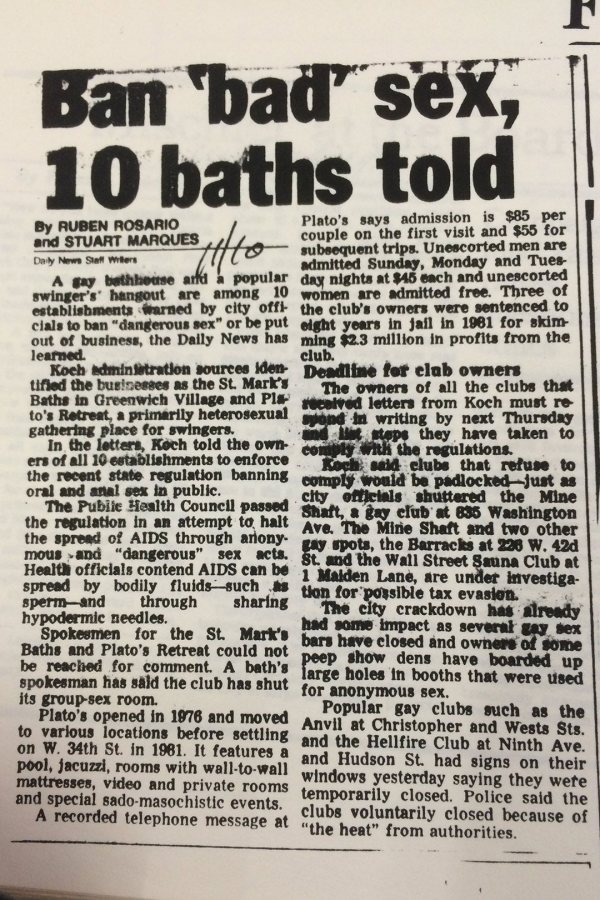
Nick Westrate (Prior Walter) and Michael Kevin Darnall (Louis Ironson) for Angels in America, Part One: Millennium Approaches. Photo by Tony Powell.
TIME OF PLAY / TIME IN PLAY
Tony Kushner’s two-part epic Angels in America deals with and is defined by time. Everything about how we experience the plays, the circumstances of their creation, and the existential quandaries of the characters are all highly charged by time. In important ways, plays routinely operate within dual, or more, timeframes. The time and place of viewing a show characterizes one timeframe. Another is marked by when and where plays are set. Additionally, time and circumstances around the creation of works offers yet another timeframe within which works function.
Angels in America premiered at San Francisco’s Eureka Theatre Company in 1991 and the Mark Taper Forum in Los Angeles in 1992. For a rewarding analysis of the creation and subsequent productions of the play, I enthusiastically recommend the book The World Only Spins Forward by Isaac Butler and Dan Kois, which presents a keenly curated oral history. Let’s look briefly at the world in which the play is set and how ideas of time are manifest in our production’s set design.
Part 1: Setting (Time of Play)
October–December 1985
Angels in America, Part One: Millennium Approaches takes place October-December 1985. This setting is just four years after the earliest official reports of what would later become known as AIDS began circulating. On June 5, 1981, the CDC (U.S. Centers for Disease Control) published an account of a rare pneumonia in five young, previously healthy gay men in Los Angeles and received a separate report from a New York dermatologist detailing a rare and aggressive cluster of cancer called Kaposi’s Sarcoma, or KS. Within days, the Associated Press and other media outlets ran reports of similar cases around the nation.
On September 24, 1982, the CDC introduced the term “AIDS” (Acquired Immune Deficiency Syndrome). Prior to that, the illness was variously described as “Gay Men’s Pneumonia,” “gay cancer,” “mysterious fever,” and “GRID” (Gay Related Immune Deficiency). While the first commercially available blood tests to detect HIV (Human Immunodeficiency Virus, a retrovirus which causes AIDS) were rolled out in 1985, there was no cure nor workplace anti-discrimination protections for individuals living with HIV/AIDS. Most initial labels and early media reports emphasized that outbreaks were happening exclusively within gay male communities, which facilitated indifference and silence in the wider public.
The Reagan Administration was alarmingly silent on the AIDS epidemic. In July 1985, Hollywood leading man Rock Hudson became the first major U.S. public figure to announce that he had AIDS.

NYTimes – July 30, 1985
In the six months following his acknowledgment, AIDS stories in major print media more than tripled. President Reagan and Hudson were known to be close friends; yet Reagan did not publicly utter the word AIDS until asked about it in a September 17, 1985 news conference during which he embellished his administration’s support and the scale of government programs’ commitment to AIDS research. Hudson died of AIDS-related illness less than three months later. Days later, in an October 15, 1985 White House press briefing, Press Secretary Larry Speakes made repeated jokes about AIDS. Responding to a reporter’s questions about the CDC’s recent designation of AIDS as an epidemic, Speakes retorted, “What’s AIDS? I don’t have it. Do you?” followed by “I don’t know anything about it.” Transcripts indicate that there was laughter throughout the press conference as Speakes continued to play off reporters’ questions for laughs.
While Speakes and others laughed, HIV and AIDS decimated communities. In late October 1985, New York State authorized local health officials to close gay bathhouses, bars, clubs, and other places where “high-risk sexual activity takes place.” The closure of these establishments energized late night Central Park as a cruising ground for gay men to meet, as shown in Millennium Approaches.
Figures from 1985 showed an 89% increase in new AIDS cases compared with 1984, and public health experts predicted twice as many new AIDS cases in 1986. Between June 1, 1981 and January 13, 1986, the CDC recorded 16,458 AIDS patients (16,227 adults and 231 children), who, on average, died about 15 months after diagnosis. By fall and winter of 1985, documented AIDS cases stretched outside gay male communities to include hemophiliacs, women, and children, as experts confirmed that spread could occur by sexual transmission and carried via blood, including passing from birth parent to newborn. Earlier in the year, an Indiana teenager who contracted HIV during treatment for his hemophilia was refused entry to his middle school. By year’s end, a Los Angeles Times poll showed that most Americans favored quarantining people with AIDS.

The New York Daily News of Nov. 10, 1985
Part 2: Set (Time in Play)
Set designer Maruti Evans recognized how important the concept of time is to Angels in America and worked to create a set to illustrate the point. “We began by discussing time and its counterpart mortality,” said Evans. “Time is such a constant throughout the piece. You are almost always aware of a clock ticking constantly in the background…We used a physical manifestation of the clock, inspiration from ACT UP scattering ashes into the White House Rose Garden, and the art of David Wojnarowicz, who created images where he’d bury himself alive in anticipation of own demise due to AIDS.”
“I imagine what it would be like if each time a lover, friend or stranger died of this disease, their friends, lovers or neighbors would take the dead body and drive with it in a car a hundred miles an hour to Washington DC and blast through the gates of the White House and come to a screeching halt before the entrance and dump their lifeless form on the front steps. It would be comforting to see those friends, neighbors, lovers and strangers mark time and place and history in such a public way.”
In 1992 and 1996, members of ACT UP organized political funerals and protests in which they called for people to bring cremated remains of loved ones lost to AIDS for a funeral procession culminating in depositing ashes on the White House lawn. Both Ashes Actions were timed for October when the AIDS Memorial Quilt was on display on the National Mall and weeks before presidential elections.

October 13, 1996. Photo courtesy of ACT UP NY. Their caption: “ACT UP took the cremated human remains of those we have loved who were murdered by AIDS and killed by government neglect throwing the ASHES onto the White House Lawn.”
Utilizing these moments from the 1980s AIDS crisis, Evans created a circular set to evoke a clock and filled it with sand to symbolize the sands of time as well as represent the ashes of AIDS victims.
We hope you will join us for this incredibly powerful production of Angels in America. There is limited time. The show runs until April 23. Tickets are available now.




